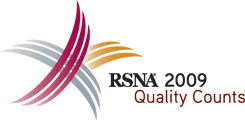
Abstract Archives of the RSNA, 2009
SSE15-05
Comparison between Manual Segmentation, Targeted Thresholding, and Gaussian Deconvolution of Synovitis in the Osteoarthritic Knee Using Contrast-enhanced (CE) Fat-suppressed T1-weighted MRI
Scientific Papers
Presented on November 30, 2009
Presented as part of SSE15: Musculoskeletal (Quantitative Imaging)
A. Kassel Fotinos-Hoyer BS, Presenter: Employee, Perceptive Informatics, Inc
Ali Guermazi MD, Abstract Co-Author: Stockholder, Synarc, Inc
President, Boston Imaging Core Lab, LLC
Research grant, General Electric Company
Research Consultant, Merck KGaA
Hernan Jara PhD, Abstract Co-Author: Patent holder, Virtual Magnetic Resonance Imaging
Hussain Khrad MD, Abstract Co-Author: Nothing to Disclose
Klaus Bohndorf MD, Abstract Co-Author: Shareholder, Boston Imaging Core Lab, LLC
Frank W. Roemer MD, Abstract Co-Author: Shareholder, Boston Imaging Core Lab, LLC
To compare two automated methods of determining synovitis volume in the knee with automatic segmentation.
The right knees of 32 patients with clinically defined osteoarthritis were scanned using CE T1-w sequences on a 1.5T MRI. Images were manually segmented and synovitis volume was calculated using proprietary software (Perceptive Informatics, Inc.). Volumetric assessment of synovitis was automatically generated using targeted thresholding and Gaussian deconvolution techniques. Volumes obtained via manual segmentation and via automated methods were plotted against one another and the distributions were fit with linear functions. To define intra-observer reliability for the reference standard of manual segmentation, 5 randomly chosen knees were re-segmented. Manually segmented volumes obtained initially and for re-segmented knees were plotted against one other and the data was fit with a linear function.
Manual segmentation data plotted against targeted thresholding data yielded a 1.085 slope and a 0.8757 R2 value. Manual segmentation data plotted against Gaussian deconvolution data yielded a 0.7478 slope and a 0.8185 R2 value. Manual segmentation volumes repeated for variability analysis plotted against the volumes originally obtained yielded a 0.9477 slope and a 0.919 R2 value. Manual segmentation required 45-75 min. per case whereas automated methods required 10-15 min. per case.
Obtaining synovitis volumes via targeted thresholding is an effective, efficient alternative to manual segmentation. Targeted thresholding generates results which are well correlated with manual segmentation results and reduces segmentation times by about 80%. Differences between the methods were due to synovitis surrounding cysts outside of the joint capsule, partial volume averaging, enhancing bone lesions/blood vessels within the bones of the knee, flow artifact from the popliteal vessels and enhancing blood vessels within the soft tissue. Gaussian deconvolution methods provide results which are correlated with manual segmentation results but are not as accurate as targeted thresholding results. Gaussian deconvolution requires an additional 2-3 minutes per case as compared with targeted thresholding.
Automated assessment techniques could allow synovitis volumes to be used clinically and as a biomarker for the effectiveness of interventional therapy targeting synovitis reduction.
Fotinos-Hoyer, A,
Guermazi, A,
Jara, H,
Khrad, H,
Bohndorf, K,
Roemer, F,
Comparison between Manual Segmentation, Targeted Thresholding, and Gaussian Deconvolution of Synovitis in the Osteoarthritic Knee Using Contrast-enhanced (CE) Fat-suppressed T1-weighted MRI. Radiological Society of North America 2009 Scientific Assembly and Annual Meeting, November 29 - December 4, 2009 ,Chicago IL.
http://archive.rsna.org/2009/8006902.html

